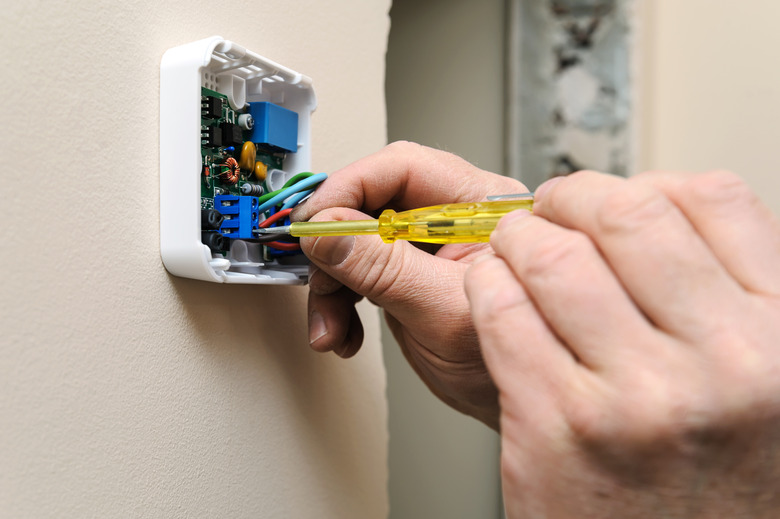How To Wire A Thermostat With A Blue Wire
We may receive a commission on purchases made from links.
Take your existing thermostat off the wall — it's usually easy to do — and turn it over. You'll see wires of many colors, and one of those might be the thermostat blue wire. If so, look at the terminal to which it's attached and you'll probably see the letter C. The blue wire, or C-wire, is known as the common wire. It's there to provide power to the thermostat so it doesn't need to use battery power all the time (in this case, batteries provide backup power).
Older thermostats don't usually have a C-wire because they don't need power, or if they do, they get it from batteries. The modern digital thermostat is a different story. Most have programmable functions, Wi-Fi connectivity, lights, and an LED screen that all need power, and wiring them to the 24-volt transformer on the heating/cooling system control board is more efficient than using a battery. Power comes into a blue-wire thermostat on a red wire connected to the transformer and returns to the transformer on the C-wire, which is usually blue, but it can be black.
Thermostat Wire Color Code
Thermostat Wire Color Code
When doing HVAC wiring, technicians usually follow a standard color code for the wires, but they aren't as rigorous about it as electricians are about electrical wires, and they may occasionally use a different color. You shouldn't always assume that the colored wires at the thermostat are performing their standard functions. The best way to make sure is to check the letter on the thermostat terminal to which each wire is attached. If you have wires sticking out of the wall but no thermostat, check the colors of the wires attached to the terminals on the control panel of your heating/cooling unit.
If everything is hooked up according to industry standards, the wires serve the functions described in the following table.
Thermostat Wiring Color Code Guide
|
Wire Color |
Function |
Connects To |
Notes |
|
White |
Turns the heating system on and off |
W terminal |
|
|
Yellow |
Controls the heat pump compressor |
Y terminal |
|
|
Green |
Controls the blower in the air handler |
G terminal |
|
|
Orange |
Controls the heat pump reversing valve |
O terminal |
Used for HVAC systems that include a reversible heat pump |
|
Brown |
Controls second-stage or emergency heat |
W2 terminal |
Used for two-stage heating systems |
|
Red |
Supplies power from 24V transformer systems |
R terminal |
Systems with AC and heat need an RH terminal to control the heat and an RC terminal for the AC. The RH and RC are usually bonded so both get power from a single R wire. |
|
Blue/Black |
Provides a return path for thermostat functions that need power. This thermostat wire is also known as the common wire, or C-wire. |
C terminal |
Some thermostats have a B terminal that functions like an O terminal —the blue wire connects to the B terminal; a black wire connects to the C terminal as the common wire. |
In complex setups that include a wire terminal to control the air conditioning system condenser for second-stage cooling as well as more terminals for other auxiliary functions, such as a humidifier or dehumidifier, you may see one or more terminals marked AUX. There's no standard color scheme for making the wire connection to these terminals.
Wiring a New Thermostat
Wiring a New Thermostat
Most smart thermostats, such as Nest thermostats featuring internet connectivity, have a common terminal. If the wires in your wall include a blue wire, you're all set. You can attach it to the connector for the thermostat C terminal.
The first step in any thermostat installation is to shut off the power to the system (turn off the breaker) to avoid blowing any fuses or getting a slight shock. Next, connect the blue wire to the C terminal to make it the C-wire and make sure it's connected to the C terminal at the HVAC control panel. If you have a Rheem or Rudd thermostat and a heat pump system, you may see a black wire as well as a blue one in the wire set. If so, the black one is probably the C-wire, but you should check the wiring diagram on the system control board to make sure.
What If There Is No Thermostat Blue Wire?
What If There Is No Thermostat Blue Wire?
If you want to hook up a new programmable thermostat that has a C terminal but you don't have a blue wire because your old thermostat didn't need one, you'll have to install a blue wire. Most homeowners will elect to hire an HVAC technician for this, but if you want to DIY it, you can either run that wire separately from the system control panel to the thermostat or (preferably) run a new cable that includes all the wires you need. Use 16- or 18-gauge wire as specified by the manufacturer of your heating/cooling system.
